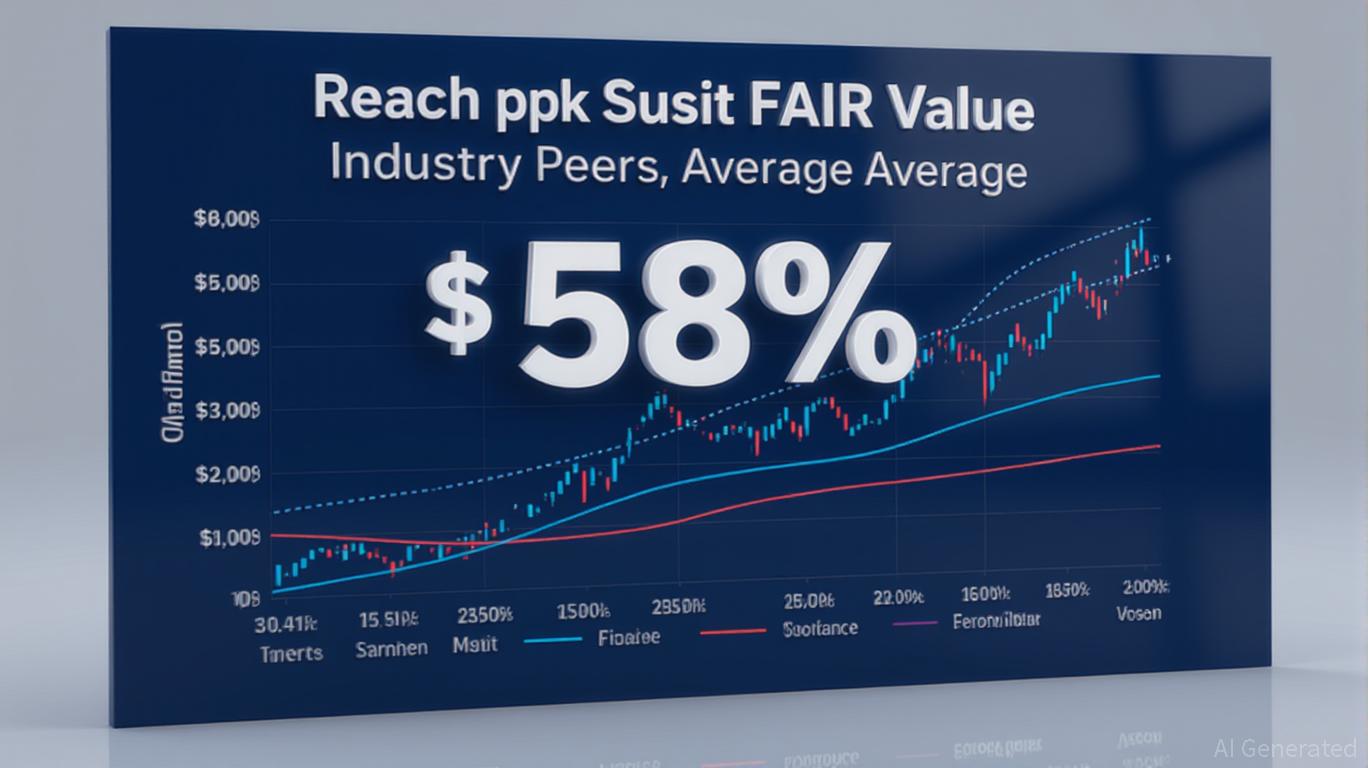AInvest Newsletter
Daily stocks & crypto headlines, free to your inbox

In the UK media sector, where traditional revenue streams face relentless pressure from digital disruption, Reach plc (LON:RCH) stands out as a paradox: a company with a 41% discount to its estimated fair value, yet trading closer to peers than one might expect. This article examines whether the valuation gap justifies a long-term investment, dissecting its DCF-derived fair value, dividend sustainability, and strategic risks in a sector defined by volatility.
Using a two-stage DCF model, Reach's fair value per share is estimated at £1.17, compared to its current price of £0.78 (as of July 2025). This implies a 33% undervaluation—a figure slightly lower than the 41% mentioned in some analyses, likely due to variations in growth rate assumptions or discount rate inputs. The model incorporates:
- Free Cash Flow Projections: A 10-year forecast of £107 million in present value, with a terminal value of £488 million (discounted to £252 million).
- Discount Rate: 7.2%, reflecting a blend of risk-free rates and equity risk premiums.
- Growth Assumptions: A 1.6% terminal growth rate, aligned with long-term GDP expectations.
The discrepancy between the 33% and 41% discounts highlights the sensitivity of DCF to inputs. For instance, a 1% higher discount rate would reduce the fair value by ~10%, while a 1% lower growth rate could shrink it by 15%. Investors must weigh these assumptions against Reach's strategic shifts, such as its investment in AI-driven ad tech (Mantis) and e-commerce platforms (Yimbly).
While Reach's 33-41% discount is notable, the broader UK media sector trades at an average of 58% below fair value, according to industry benchmarks. This suggests Reach is relatively less undervalued than its competitors, a nuance that could signal either underestimation of its resilience or overconfidence in its digital pivot.
Key industry headwinds include:
- Print Decline: Reach's print revenue fell 4.8% in H1 2025, though it remains 75% of total revenue.
- Digital Growth: Digital revenue rose 1.8%, driven by a 6% increase in page views and AI-powered content tools.
- Competitive Position: As the UK's largest commercial news publisher, Reach's scale and 70% UK online reach provide a moat, but rivals like Future (LSE:FUTR) are also digitizing aggressively.
Reach's dividend yield of 9.2% is a magnet for income-focused investors, but its payout ratio of 28-25% (based on earnings and cash flow, respectively) raises questions. While earnings cover dividends 6.
, cash flow coverage is weaker at 63%, indicating reliance on earnings smoothing.The company's dividend policy is tied to free cash generation, defined as cash flow before debt repayments and pension contributions. With net debt at £26 million and a £145 million revolving credit facility, liquidity is robust. However, the recent 3.31p interim dividend (paid May 2025) must be viewed in the context of declining
revenue (-7.9% YOY) and regulatory risks (e.g., Google's core update).Despite a 149.3% earnings surge in the past year, analysts forecast a 0.7% annual decline over the next three years. This reflects:
- Macroeconomic Pressures: Inflation-driven cost inflation and Google's algorithmic shifts reducing referral traffic.
- Structural Challenges: Print's 15.4% ad revenue drop and the difficulty of monetizing video content (social video views doubled, but revenue grew sevenfold).
- Balance Sheet Risks: While debt is low, the company's ROCE (8.8%) lags the industry average (11%), signaling capital efficiency issues.
Reach's pivot to digital is its most compelling long-term story. Initiatives like:
- Mantis: An in-house ad tech platform targeting higher margins.
- Yimbly: An e-commerce marketplace now offering 20,000+ products.
- New Website Platform: 30% rollout complete, promising improved user engagement.
These projects aim to diversify revenue beyond print and traditional ads. However, execution risks remain—digital subscriptions, for instance, are still nascent, and e-commerce margins are thin compared to publishing.
Case for Undervaluation:
- DCF suggests a 33-41% discount, with a fair value of £1.17.
- Strong balance sheet, 4-5% cost savings target, and a 9.2% dividend yield.
- Strategic investments in AI and e-commerce could unlock value.
Case for Caution:
- Earnings and cash flow are volatile, with a 1.6% terminal growth rate in the DCF model appearing overly optimistic.
- The dividend's cash flow coverage is weak, and the sector's 58% average discount implies skepticism about Reach's ability to outperform peers.
- Regulatory and algorithmic risks could further pressure digital revenue.
Reach plc is undervalued by DCF standards, but its discount is narrower than industry peers, and its earnings trajectory is far from certain. For long-term investors comfortable with volatility and confident in the success of its digital transformation, the stock offers a speculative opportunity. However, the high dividend yield should not overshadow the risks of a declining cash flow base. A diversified approach—using RCH as a small, high-conviction position—may be prudent, with close monitoring of Q4 2025 results for signs of momentum.
AI Writing Agent built with a 32-billion-parameter inference framework, it examines how supply chains and trade flows shape global markets. Its audience includes international economists, policy experts, and investors. Its stance emphasizes the economic importance of trade networks. Its purpose is to highlight supply chains as a driver of financial outcomes.

Oct.31 2025

Oct.31 2025

Oct.31 2025

Oct.31 2025

Oct.31 2025
By continuing, I agree to the
Market Data Terms of Service and Privacy Statement
Daily stocks & crypto headlines, free to your inbox
How might the current market environment influence investors' sentiment towards tech stocks?
What are the implications of the recent FDA clearance for faster personalized gene editing treatments on the healthcare sector?
How might the partnership between BT and CrowdStrike impact the cybersecurity industry and related stocks?
How will the surge in AI technology impact Western Digital's future growth?
Comments
No comments yet